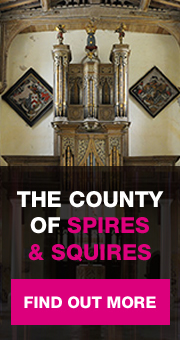Externally it is the late 15th century tower that grabs one’s attention. It was built by Lord Lovel, Lord Chamberlain to Richard lll. It is by far and away one of the most impressive in the county. It rises through five stages incorporating a west door, large lancet windows, gothic panels that now support the clock face, three further lancet windows, and finally turrets which form the base to a crocketed spire.
The main body of the church is one of accretion from the Norman period to the present day, that said this roomy church overall has in it’s nave a feeling for the perpendicular period and in it’s chancel the Victorian.
Overall it is large and airy. This should be, but isn’t, the resting place of the Lovel family. If they were ever here they are now gone. After their disgrace, Henry VII, victor of Bosworth Field, granted the manor to his associate, Sir Charles Somerset, in 1486. Somerset’s grandson sold it to Gilbert Pickering in 1553 and it is the monuments to the Pickerings and their collaterals that abound here.
Of the early Pickerings only a great inscribed stone records them, generation by generation up to 1766 in the north aisle. There are three collateral branches which should be mentioned, the Drydens, the Pepys, and the Creeds.
In the 17th century John Pickering married Susannah Dryden whose brother, Erasmus, who also married a Pickering was the father of the poet John Dryden.
In the same century the daughter of Sir Sidney Montagu (of Barnwell) and Paulina Pepys married Mr Creed of Oundle. Their grandson, John married Elizabeth Pickering, the artist (circa 1642-1728) who was well known to Samuel Pepys. The diarist was surprised when she married his colleague in the Navy Office, John Creed of Oundle as he felt him slightly dull.
It was after her husband’s death in 1700 that she moved back to Northamptonshire from London and became both an artist and a philanthropist. She lived largely at Barnwell where she taught needlework and art. From here she executed a number of commissions in local churches, largely for her relatives – Barnwell, Canon’s Ashby as well as here at Titchmarsh.
The first independent Pickering tomb is that to Theopholus (d. 1710) and was executed by her. As with all her memorials it is in paint rather than stone or marble. High above he appears as a painted bust set on a plinth with armorial columns to either side. Also in the north aisle you’ll find Mrs Creed’s tombs to Erasmus Dryden and Mary Pickering, his wife, (d.1722). This time topped with a carved bust of their son John Dryden, the poet.
Erasmus and his wife lived at nearby Aldwynckle where their son was born. In the south aisle Mrs Creed created two further tombs. To her son Major Richard Creed who fell at Blenheim (1704) and his sister Jemima. Painted decoration again, he is suitably surrounded by military trophies whilst she has a still life of flowers. Here you will also find a memorial to Mrs Creed’s husband, John and a stark urn in the window dedicated to the memory of Mrs Creed herself.
This is somewhat at odds when compared to her own baroque exuberance. It was supplied at the end of the 18th century by J & J Coles of nearby Thrapston. Nearby the tomb to John Creed and his wife, Mary, circa 1760, is by Edward Bingham (circa 1720-1791) of Peterborough who supplied a number of tombs in the Cathedral. This early work is almost contemporary with the carved chimneypieces he made for Lord Fitzwilliam at Milton.
Please refer to the Glossary for any terms in the text that you are unfamiliar with.







